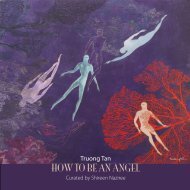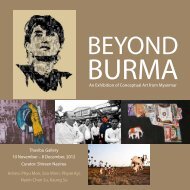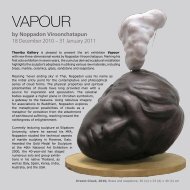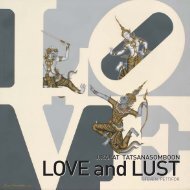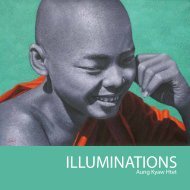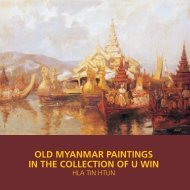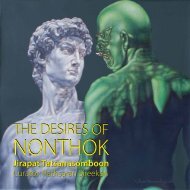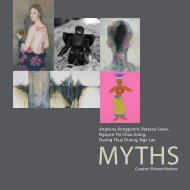CHAW EI THEIN and HTEIN LIN - Thavibu Gallery
CHAW EI THEIN and HTEIN LIN - Thavibu Gallery
CHAW EI THEIN and HTEIN LIN - Thavibu Gallery
Create successful ePaper yourself
Turn your PDF publications into a flip-book with our unique Google optimized e-Paper software.
<strong>CHAW</strong> <strong>EI</strong> TH<strong>EI</strong>N <strong>and</strong> HT<strong>EI</strong>N <strong>LIN</strong><br />
STORIES<br />
OUT OF<br />
BURMA<br />
<strong>Thavibu</strong> <strong>Gallery</strong>, 13 November – 4 December, 2010<br />
Curator: Shireen Naziree
STORIES<br />
OUT OF<br />
BURMA<br />
<strong>Thavibu</strong> <strong>Gallery</strong>, 13 November – 4 December, 2010<br />
Curator: Shireen Naziree
Published 2010 by<br />
<strong>Thavibu</strong> <strong>Gallery</strong> Co., Ltd.<br />
Silom Galleria, Suite 308<br />
919/1 Silom Road, Bangkok 10500, Thail<strong>and</strong><br />
Tel. 66 (0)2 266 5454, Fax. 66 (0)2 266 5455<br />
Email. info@thavibu.com, www.thavibu.com<br />
Layout by Wanee Tipchindachaikul, Copydesk, Thail<strong>and</strong><br />
Copyright <strong>Thavibu</strong> <strong>Gallery</strong><br />
All rights reserved. No part of this publication may be reproduced or transmitted in any form or by any<br />
means, electronic or mechanical, without prior permission in writing from the publisher.<br />
4 STORIES OUT OF BURMA
STORIES OUT OF BURMA<br />
Shireen Naziree<br />
The identification of artists with exalted yearnings is<br />
typically associated with freedom of speech <strong>and</strong> place.<br />
Their visual dialogues are abound with sensory journeys<br />
where geographical place is intertwined with metaphysical<br />
space – often the silent <strong>and</strong> contemplative<br />
arena that allows for their narratives to be read with<br />
all the sensibilities that have been applied to their art.<br />
Many contemporary artists, mobilized by the art world’s<br />
globalization, often unknowingly enlist the nomadic in<br />
their work. In contrast, how precisely does an exiled artist<br />
encode this position?<br />
Stories Out Of Burma provokes the geographical distance<br />
as well as the space between the hidden <strong>and</strong> the visible<br />
through the art of Htein Lin <strong>and</strong> Chaw Ei Thein – Burma’s<br />
most profiled exiled artists. With Htein Lin in London <strong>and</strong><br />
Chaw Ei Thein in New York, the artists live <strong>and</strong> work at<br />
the crossroads of the global art arena. Discounting their<br />
vantage points, both their artistic exchanges remain<br />
deeply intertwined with their individual <strong>and</strong> social<br />
relationship with their native Burma. Through their<br />
individual <strong>and</strong> personal introspective to the literal <strong>and</strong><br />
equating social environment of their homel<strong>and</strong>, Stories<br />
Out Of Burma invokes a consideration of how history <strong>and</strong><br />
place can control <strong>and</strong> limit the experience of freedom<br />
as much as physical barriers.<br />
For questions of emotion - human experiences <strong>and</strong><br />
authenticity are integral to the framing of art practice<br />
in order to communicate meaning. Inscribed within the<br />
personal histories of Htein Lin <strong>and</strong> Chaw Ei Thein are<br />
their own nostalgia which they give meaning to through<br />
the pursuit of visual culture that has variously annexed<br />
painting <strong>and</strong> conceptual art practices. For both artists<br />
the use of specific media at certain points of their careers<br />
signified their realism of human experience <strong>and</strong> at<br />
times emotions they had to negotiate. As the obscurity<br />
<strong>and</strong> the fragile nature of their traditional socio-political<br />
environment is called into question – the conditions<br />
of their artistic practices tell us a great deal about their<br />
dialogue <strong>and</strong> their relationship with other cultures. But<br />
more importantly, together with forces from within,<br />
they create a very individual third space that allows<br />
for glimpses of situations – rarely accessible otherwise.<br />
As such, both their artistic practices from the periphery<br />
are drawn into the closely knit Burmese Diaspora<br />
while steering a careful course between the foreign <strong>and</strong><br />
the familiar; producing transcultural hybrids that are<br />
engaging on varied levels, reminding us of the hardship<br />
of human existence.<br />
Stories Out Of Burma presents various sites of contention<br />
in terms of identity, geography <strong>and</strong> social history<br />
as both Htein Lin <strong>and</strong> Chaw Ei Thein find refuge in art<br />
as well as enriching the experience of art - by making it<br />
more responsive through the issues they raise from their<br />
perspectives. Beyond art, they are bound together by a<br />
social history <strong>and</strong> common currency that makes their<br />
aesthetic expressions unique in the broader considerations<br />
of Burmese contemporary art practice. They both<br />
STORIES OUT OF BURMA 5
view Burma with endless reflection about life experience<br />
as crucial for underst<strong>and</strong>ing the nature of their artistic<br />
debates due to the connection between cultural <strong>and</strong><br />
ideological positions.<br />
Contemporaries at the University of Rangoon, both<br />
Htein Lin <strong>and</strong> Chaw Ei Thein graduated in law in 1994.<br />
In principle a law degree should have offered them<br />
a firm foundation for prospective careers; however<br />
they were both grounded in more artistic <strong>and</strong> culturally<br />
configured spaces. Chaw Ei Thein did explore the<br />
possibilities of practicing as a lawyer while Htein Lin<br />
realized from the outset that the defining temperament<br />
of the practice of law corresponded best to the rhetoric<br />
of performance art.<br />
Though both artists’ engagement with more traditional<br />
artistic concerns were present since early in their childhood,<br />
their socio-political mindfulness set them apart<br />
from the mainstream <strong>and</strong> the art scene in general,<br />
especially at a time when Burma’s social history was<br />
being called into question. They openly voiced concerns<br />
over the political imbalances that have resulted in the<br />
endless injustices to the Burmese people. With these<br />
v i s i o n s a n d i m p e r a t i v e s , a s a r t i s t s t h e y w e r e a b l e t o<br />
rewrite their expressionism from a more hybrid perspective<br />
that would ultimately see them both being exiled<br />
from Burma.<br />
Both artists had been regular participants in group<br />
art exhibitions in <strong>and</strong> around Rangoon with art<br />
collectives such as the Gangaw Village Art group <strong>and</strong><br />
on university campus in 1994 <strong>and</strong> 1995. However their<br />
fi r s t c o m b i n e d a r t i s t i c c o l l a b o r a t i o n a n d o n e o f t h e i r<br />
most notable would be ten years later in May 2005.<br />
Their street performance Mobile Art <strong>Gallery</strong> <strong>and</strong> Mobile<br />
Market in Rangoon resulted in their detention by the<br />
authorities for five days. Together <strong>and</strong> individually their<br />
performance art has been regarded as provocative <strong>and</strong><br />
telling; earning them sound recognition in Burma <strong>and</strong><br />
abroad. Probably their most notable piece has been<br />
On the Table, performed to an international audience<br />
in Rangoon later that year. Chaw has described On the<br />
Table as being one of their most significant pieces of<br />
performance art.<br />
On the Table, 2005<br />
Chaw Ei Thein <strong>and</strong><br />
Htein Lin<br />
Rangoon<br />
6 STORIES OUT OF BURMA
Htein Lin had developed On the Table much earlier –<br />
having performed it for the entertainment of his peers<br />
during his years as a political exile in the jungles of<br />
Burma <strong>and</strong> while in prison – the work took on a new <strong>and</strong><br />
political meaning when he redesigned it in 2005. With<br />
Chaw Ei Thein dressed as Daw Aung Sang Suu Kyi when<br />
she was released from prison in 2002, On the Table was<br />
a representation of the events that followed her release;<br />
her attempts to cooperate with the ruling junta, the<br />
fear of her supporters that such actions would damage<br />
her reputation <strong>and</strong> the ultimate dissatisfaction of the<br />
government by Daw Aung Sang Suu Kyi’s refusal of<br />
t heir offe r s t hat finally l ed to a mistrust bet ween the t wo<br />
opposing factions. They would later in 2007 perform<br />
On the Table in London during the opening of Htein Lin’s<br />
exhibition of his prison series at Asia House.<br />
Amassed <strong>and</strong> collated, both their artistic practices<br />
take on strong meaning here as the central position of<br />
performance art is emotionally moving <strong>and</strong> offers<br />
aesthetic qualities that commensurate the relationship<br />
between experience <strong>and</strong> representation. The immediacy<br />
o f p e r fo r m a n c e a r t h a s a l l o w e d b o t h H t e i n L i n a n d<br />
Chaw Ei Thein to reveal hidden truths <strong>and</strong> reach a<br />
w i d e r a u d i e n c e . A n o t h e r e l e m e n t m o s t a p p a r e n t i n<br />
their artistic vocabulary is the fluid status with which<br />
they are able to reconfigure their representations.<br />
Stories Out Of Burma makes tangible the shape of some<br />
of these experiences <strong>and</strong> holds a mirror up to the<br />
complexities <strong>and</strong> contradictions that they encompass.<br />
Htein Lin<br />
Scale of Justice, 2009<br />
Singapore<br />
Htein Lin states that art <strong>and</strong> creativity was something<br />
he was born with <strong>and</strong> as such has been an integral<br />
part of his world. Very much a self taught artist, he is<br />
well known for his iconic painterly style <strong>and</strong> his use<br />
of unconventional materials <strong>and</strong> methods. While in a<br />
refugee camp in the jungle, Htein Lin met the M<strong>and</strong>alay<br />
artist, Sit Nyein Aye who taught him the formal aspects<br />
of painting. Besides teaching him the fundamentals of<br />
drawing, Sit Nyein Aye also exposed Htein Lin to the<br />
artworks of foreign artists, such as “The Sunflowers“ by<br />
Vincent van Gogh, which he would verbally describe as<br />
they had no reading materials.<br />
STORIES OUT OF BURMA 7
Htein Lin<br />
Biology of Art, 2007<br />
Even then, the politics of Htein Lin’s work was of a<br />
different order altogether. His work explored the subtle<br />
densities <strong>and</strong> surfaces of his manifest world, investing<br />
in every detail with his full attention. The numerous<br />
paintings that he executed during the period he termed<br />
as “Biology of Art” were his years as a political refugee<br />
<strong>and</strong> prisoner. At the time, Htein Lin’s work investigated<br />
the potential to extend the body’s senses by subverting<br />
or transforming their functions. While in the prison ward<br />
of a hospital in M<strong>and</strong>alay, his cellmate Soe Moe Naing,<br />
who was sentenced to twenty years imprisonment, gave<br />
him his shirt which would serve as his canvas. Another<br />
cellmate, the poet Maung Tin Thit who had trained as<br />
a doctor taught Htein Lin basic anatomy. In this series,<br />
paintings map the route of food through tortured<br />
passages into a stomach filled with thorns <strong>and</strong> razor<br />
blades. But the heart is full of flowers.<br />
Such richness in the choice of his materials <strong>and</strong> the<br />
atricality of his approach continues to come together<br />
in a body of work that conveys both enormous<br />
self-confidence <strong>and</strong> the need to question. His<br />
diverse pictorials continue to lend themselves to the<br />
complexities <strong>and</strong> the transposition of cultural values<br />
though Htein Lin has never been overly concerned about<br />
being pretentious about being an artist; he maintains an<br />
unnostalgic erasure of the hierarchy of art. This erasure<br />
became fundamental to the shift in perception Htein<br />
Lin’s art has opened up so many years later. He observes<br />
everything, especially intentional human activity which<br />
often anchors his diverse subjects. The monoprint<br />
painting style, using his fingers, that he developed during<br />
this period recurs in paintings such as in People’s Desire<br />
<strong>and</strong> in How do you Find London.<br />
People’s Desire (1),<br />
2010<br />
Acrylic <strong>and</strong> mixed<br />
media on canvas<br />
91 x 91 cm<br />
8 STORIES OUT OF BURMA
People’s Desire (2), 2010<br />
Acrylic on canvas<br />
91 x 61 cm<br />
Htein Lin’s experiences allow him to construct<br />
contemporary versions of a parallel world with his<br />
own language that remakes itself as flexible <strong>and</strong><br />
knowing to his viewers. How do you Find London is<br />
testament to that as he recasts his pictorial with the<br />
pace <strong>and</strong> proximity of his lived experience. The title of the<br />
painting is telling in itself as the common question “How<br />
do you find London?” was one that Htein Lin constantly<br />
encountered when he first moved to the city in 2006.<br />
A topography of London’s iconic l<strong>and</strong>marks that evokes<br />
an interesting negotiation across the city, a mapping<br />
punctuated <strong>and</strong> anchored traces his own involvement<br />
with the city. For example, he has replaced the statue<br />
of Lord Nelson in Trafalgar Square with that of Lord<br />
Buddha, indicating his preference for a representation<br />
of peace over that of war. Thus the object of Htein Lin’s<br />
expressionism becomes the screen enabling the<br />
emergence <strong>and</strong> negotiations of an otherness.<br />
encodings of vision. In this context, he felt himself<br />
emotionally str<strong>and</strong>ed within Bangkok’s telescopic<br />
l<strong>and</strong>scapes <strong>and</strong> diminished cultural l<strong>and</strong>marks. As he<br />
draws comparisons with the flat <strong>and</strong> placid pace of<br />
Rangoon, the imagery in the artwork compress <strong>and</strong><br />
distribute various layering, as he acknowledges his<br />
i n t e r e s t i n t h e p o l i t i c a l t u r m o i l b e t w e e n t h e T h a i<br />
government <strong>and</strong> the Red Shirt protestors. He equally<br />
recognizes the negative impact that the amplifying of<br />
such events may have on Burma’s own fragile political<br />
climate as the two countries share common spiritual<br />
values.<br />
This type of emergence is precisely what recurs in<br />
How do you Find Bangkok. Rather than a survey of sites,<br />
Htein Lin’s works are often an index of encounters<br />
a n d e v e n t s t h a t h e j u x t a p o s e s w i t h h i s o w n c u l t u r a l<br />
How do you Find Bangkok?, 2010<br />
Acrylic on canvas<br />
101 x 101 cm<br />
STORIES OUT OF BURMA 9
More on point is knowing Htein Lin’s resourcefulness<br />
in conceiving <strong>and</strong> executing alternatives in both<br />
de–<strong>and</strong> re-construction such as old prison uniforms as<br />
canvasses <strong>and</strong> using his body parts to apply pigments.<br />
But despite such juxtapositioning of ideas <strong>and</strong> material<br />
he is able to accommodate unallied approaches such<br />
as the cross circuiting of the conventional identity of<br />
painting practices as in People’s Desire. Here, imprints<br />
o f h i s h a n d s a re s t a m p e d w i t h s y m b o l s o f B u d d h i s m<br />
a n d B u r m a ; t h e b o d h i l e a f , t h e w h e e l o f d h a r m a ,<br />
peacock feathers, coconut fronds <strong>and</strong> decorative<br />
awnings of old palaces - all symbols of peace, yet<br />
paradoxes to the negative propag<strong>and</strong>a of the current<br />
Burmese government. Similarly, he further punctuates<br />
the connectedness between his body <strong>and</strong> his<br />
art in his performance piece Homage to the Monks of<br />
Burma, whereby he traces the silhouettes of monks by<br />
outlining his body in a linear plane on a black wall while<br />
r e c o r d i n g t h e p e r f o r m a n c e t h r o u g h t i m e l a p s e d<br />
photography. Htein Lin sees such expressionism as<br />
crucial for underst<strong>and</strong>ing the nature of his artistic<br />
debates due to the connection between cultural <strong>and</strong><br />
political positions, which many would wish to remain out<br />
of sight. While he does not regard himself as a political<br />
activist, politics has provided a voice for his art.<br />
How do you Find London (in the snow)?, 2009<br />
Acrylic on canvas<br />
91 x 91 cm<br />
10 STORIES OUT OF BURMA
Saffron Revolution, 2009<br />
Acrylic on canvas<br />
24 x 30 cm<br />
Looking at Htein Lin’s work,<br />
what comes to the fore is his<br />
discourse that centers on belief<br />
<strong>and</strong> experience often defining<br />
an underlying <strong>and</strong> constant<br />
theme of his oeuvre. The monk<br />
led protest marches against<br />
Burma’s brutal military regime<br />
in September 2007 dubbed the<br />
Saffron Revolution represented<br />
an instinctive aversion of Burma’s brutal military regime.<br />
His piece Saffron Revolution is a result of such reflection<br />
because as Htein Lin explains, “I paint from my experience<br />
– I experience politics, I live in a real world <strong>and</strong><br />
it interests me. I experience Buddhism. I experience<br />
new places <strong>and</strong> I create images from them. The Saffron<br />
Revolution is such an example. The image of monks<br />
coming together is a very strong one. Respect for them<br />
is part of my personal culture.” The depiction of monks<br />
may seem as an obvious connection to make between<br />
Burma <strong>and</strong> its contemporary painting practices. However<br />
as a continuous subject what Htein Lin brings out is a<br />
distinction between a culturally given subject <strong>and</strong> the<br />
achievement of deep content.<br />
track of current events. By resisting the typical unified<br />
narrative of monks, he instead offers a cultural parity<br />
with contemporary modern art movements by allowing<br />
it the same degree of multiplicity <strong>and</strong> the right to own<br />
its own internal contradictions.<br />
The richness of his chosen materials such as gold leaf<br />
<strong>and</strong> the arrangement of repetitive forms in Homage<br />
to the Monks of Burma <strong>and</strong> also in Meditators have a<br />
quasi mystical purity born of their very simplicity, tacitly<br />
encouraging questioning <strong>and</strong> reaching for the<br />
possibility of a hidden power. While such imageries<br />
may symbolize silence, it also signifies a need for much<br />
deeper questioning of identity <strong>and</strong> situation. Together<br />
they form an index of forms that also suggest the powerful<br />
symbols of peace. This meeting of mathematical<br />
purity <strong>and</strong> vibrant color is quintessentially Htein Lin.<br />
Htein Lin is ever conscious of the ways in which art<br />
responds to the world as an invaluable tool for locating<br />
ourselves in the ever shifting now, so as to not lose<br />
Homage to the Monks of Burma (1), 2010<br />
Acrylic <strong>and</strong> gold leaf on canvas<br />
91 x 91 cm<br />
STORIES OUT OF BURMA 11
Homage to the Monks of Burma (2), 2010<br />
Acrylic on canvas<br />
91 x 91 cm<br />
Htein Lin has embraced art‘s ability to reveal complex<br />
<strong>and</strong> often universal meaning, <strong>and</strong> to practice the ideals<br />
to freedom of expression even when in his case was<br />
ironically when he was a political prisoner. “You might<br />
think that I had not experienced freedom of expression<br />
in Burma. But I did experience it when in prison, for<br />
we could not be imprisoned for expressing ourselves<br />
freely <strong>and</strong> free from the constraints of commercialism.”<br />
And if democracy is an expression of a form of ‘ideal’ in<br />
the traditional sense, Htein Lin does not contest it but<br />
draws attention to contradictions <strong>and</strong> rules that underline<br />
democracy.<br />
Multivalent <strong>and</strong> open-ended, Htein Lin’s art practice is as<br />
close as an artist comes to phrase issues <strong>and</strong> experiences<br />
that drive his work into readings that have compositional<br />
rhythms, which compliment the eye. Though the spirit<br />
of his art follows Burma’s alienation, his interest in art<br />
making has grown to a high degree of “direct symbolism”<br />
as it triggers history <strong>and</strong> actuality, his homel<strong>and</strong>,<br />
nationalism as well as personal <strong>and</strong> collective memory<br />
as Burma remains his most important symbol.<br />
Meditators, 2009<br />
Mixed media (acrylic, shan paper) on canvas<br />
100 x 70 cm<br />
12 STORIES OUT OF BURMA
Angry Wave, 2009<br />
Acrylic on canvas<br />
60 x 60 cm<br />
STORIES OUT OF BURMA 13
For both Htein Lin <strong>and</strong> Chaw Ei Thein living outside<br />
of Burma has impacted their art which has compelled<br />
t h e m t o c o n s i d e r h o w f o r m a l t e n s i o n s b e t w e e n<br />
f i g u r a t i o n a n d e x p r e s s i o n i s m c a n a s s u m e a l a r g e r<br />
socio-political meaning.<br />
Htein Lin’s radical pictorial is open <strong>and</strong> pragmatic<br />
with shapes that play off each other by repeating<br />
variations. Based on capturing events <strong>and</strong> experiences,<br />
his formalism relate directly to the social contexts that<br />
encompass his world. Chaw Ei Thein on the other h<strong>and</strong>,<br />
expresses a very different formalism that is imbued<br />
with feminism <strong>and</strong> expresses her concerns for social<br />
justice in a less obvious way. Even though Chaw Ei<br />
Thein’s pictures operate aesthetically at an opposite<br />
pole to Htein Lin’s, they are similar in their annihilating<br />
absence from Bur ma. Her ar t interac ts with inter personal<br />
relationships affected by her socio-political environment.<br />
The academics of color organization, surface <strong>and</strong><br />
structure are her necessary tools as she interweaves<br />
meaning <strong>and</strong> principles into a bigger social picture.<br />
Chaw Ei Thein’s early artistic renderings have been<br />
somewhat traditional, based on the romantic ideal<br />
of the artist’s capability of capturing original <strong>and</strong><br />
spiritual aspects of the world that would otherwise<br />
remain invisible. Her interest in art began at an early<br />
age under the guidance <strong>and</strong> tuition of her father, the<br />
painter <strong>and</strong> art academic Maung Maung Thein, which<br />
led her to win numerous international awards as a<br />
young artist. The exhibiting of her paintings alongside<br />
those of her father at Rangoon’s Lawkhanat <strong>Gallery</strong> in<br />
1991 represented her formal graduation into the art<br />
world. In Burma it is common for the work of young<br />
artists to generally reflect the influences of their mentor;<br />
Chaw was instead encouraged by her father to explore<br />
a brighter <strong>and</strong> broader palette that would represent<br />
her own ideas <strong>and</strong> look beyond the comfort of her<br />
social environment. Though this individual approach<br />
would be pivotal for her international career, in Burma<br />
it was regarded with differing response.<br />
Chaw has at times been labeled as being a political<br />
activist <strong>and</strong> criticized for mingling art <strong>and</strong> politics. Like<br />
Htein Lin her creativity is deeply enmeshed in her life<br />
experiences <strong>and</strong> she st<strong>and</strong>s true to her convictions.<br />
Forever searching for ways to take personal control in<br />
her artistic expressions have been challenging in the<br />
restrictive Burma’s socio-political climate. Trying to<br />
escape from the realization that many innocent people<br />
are imprisoned for their beliefs <strong>and</strong> democratic actions<br />
along with the current living environment in Burma<br />
has been part of her inner conflict, <strong>and</strong> she attests<br />
that art is a constructive means of highlighting that<br />
socio-political realm.<br />
While Chaw Ei Thein’s work is not overtly political; she<br />
has developed an artistic portfolio with a series of<br />
forms when juxtaposed, address contemporary realities<br />
through careful intimation <strong>and</strong> illusiveness. S eptember<br />
Sweetness the site-specific installation created for<br />
the 2008 Singapore Biennale by herself <strong>and</strong> Richard<br />
Streitmatter-Tran was a response to the 2007 protest<br />
by monks in Burma that was eventually crushed by the<br />
ruling military junta. The ultimate decay <strong>and</strong> collapse<br />
of the work signified the same erosion of hope by the<br />
Burmese people.<br />
14 STORIES OUT OF BURMA
Chaw Ei Thein’s arrival in New York in 2009 on a<br />
residency program under the auspices of the Asian<br />
C u l t u r a l C o u n c i l , N e w Yo r k w a s p r e l u d e d b y a n<br />
i n t e r n a t i o n a l p r o f i l e t h a t h a s b e e n a l i g n e d w i t h i n<br />
s c h o l a r l y a s w e l l a s a r t i s t i c c o n t e x t s . C h a w e a s i l y<br />
absorbed herself into the eclectic art scene of the<br />
metropolis, despite setbacks of language <strong>and</strong> cultural<br />
differences. Through her conceptual art practice, she<br />
articulated the psychological dimensions that have<br />
impacted her personal world. Her installation Bed in<br />
New York in 2009, gave out a very different model<br />
of engagement as the literal meaning of the work (a<br />
b e d c o m p o s e d o f a m u l t i t u d e o f r e d b e l l p e p p e r s )<br />
perversely played with a montage of sensuous<br />
fragments of personal memory. These elements of the<br />
wo r k re ve a l e d h e r e x t r a o rd i n a r y fl e x i b i l i t y a n d a b i l i t y<br />
to excavate from otherwise insignificant moments<br />
such as her daily traveling on New York’s subway.<br />
STORIES OUT OF BURMA 15
New York may seem to be a city of wealth, but this<br />
dynamic leads one to consider what effect these<br />
economic forces have on artists who work <strong>and</strong> live in<br />
the city. In her series of autobiographical paintings<br />
“Far Away in New York” C h aw e x p l o re s t h e e m o t i o n a l<br />
territory <strong>and</strong> the process of attempting to earn identifiction<br />
<strong>and</strong> gain a new presence within herself after<br />
her art residency ended earlier this year. With her passport<br />
impounded <strong>and</strong> threats of imprisonment a reality<br />
should she return to Burma, New York has presented itself<br />
within a very different perspective. With this uncertainty<br />
underscoring her displacement <strong>and</strong> financial future,<br />
she has only had her art through which she is able to<br />
evaluate <strong>and</strong> express these formal tensions. Despite<br />
her fears <strong>and</strong> insecurity she continues her attempts to<br />
reclaim a modernist dream against a difficult reality that<br />
encompasses values conflicting with her own.<br />
Far Away in NYC @ 231 West 25 th Street,<br />
Chelsea, Manhattan (2), 2010<br />
Acrylic <strong>and</strong> mixed media (sequin) on canvas<br />
80 x 100 cm<br />
Far Away in NYC @ 231 West 25 th Street,<br />
Chelsea, Manhattan (1), 2010<br />
Acrylic on canvas<br />
80 x 100 cm<br />
16 STORIES OUT OF BURMA
Far Away in NYC @ 86-2,<br />
57 th Road, Elmhurst,<br />
Queens, 2010<br />
Acrylic <strong>and</strong> mixed<br />
media (shawl) on canvas<br />
80 x 100 cm<br />
Chaw has referred to art as the plenipotentiary of<br />
freedom <strong>and</strong> as such she has embraced both arts’<br />
a b i l i t y t o r e v e a l c o m p l e x a n d u n i v e r s a l m e a n i n g t o<br />
freedom of expression. In contrast Chaw humbly posits<br />
her inability to have her voice heard – a muteness she has<br />
encoded in all her paintings by obliterating her mouth<br />
<strong>and</strong> exposing herself as a nude. She questions how she<br />
might gain knowledge from New York. Once again she<br />
chooses to rely on distribution <strong>and</strong> delegation as this<br />
body of work becomes an index of encounters juxtaposed<br />
with very personal <strong>and</strong> emotional encodings.<br />
While her work reflects her own displacement <strong>and</strong><br />
personal life, a more appropriate way to look at these<br />
paintings is through the idea of the self as a multiple.<br />
“We play many roles. In my studio, I am an artist. When<br />
I am commuting on New York’s subway I am someone<br />
else, possibly just another misplaced migrant.” Just as<br />
the foreignness of New York is protective, her own<br />
foreignness ensures her certain invisibility. Thus<br />
her explorations of her domestic space <strong>and</strong> the<br />
transcendence of its confinement open onto a new<br />
territory of a cold <strong>and</strong> unknowable city.<br />
Far Away in NYC @ 7520,<br />
41 st Avenue, Elmhurst,<br />
Queens, 2010<br />
Acrylic on canvas<br />
80 x 100 cm<br />
Far Away in NYC - Chaw Ei Thein<br />
in New York, 2010<br />
Acrylic <strong>and</strong> mixed<br />
media (sequins) on canvas<br />
80 x 100 cm<br />
STORIES OUT OF BURMA 17
Far Away in NYC @ Chamber<br />
Street Subway Station, 2010<br />
Acrylic on canvas<br />
80 x 100 cm<br />
In @ 86-02, 57 th Road, Elmhurst, Queens Chaw refers to<br />
the challenges she faced when her residency ended<br />
<strong>and</strong> the bright possibilities of New York started to<br />
dissipate. With an amazing interweaving of looking<br />
<strong>and</strong> meaning, Chaw draws attention to her frenzy of<br />
her social context through a restless energy that is<br />
constantly at play. With an unlikely level of poise, the<br />
interplay of loud color, organization <strong>and</strong> structure<br />
relates to the social codes to which her life had been<br />
reduced. These are themes that constantly surface in<br />
these paintings as her expressions <strong>and</strong> forms are in<br />
reality the transposition of cultural values.<br />
Far Away in NYC @ Prince<br />
Street Subway Station, 2010<br />
Acrylic on canvas<br />
80 x 100 cm<br />
Chaw Ei Thein’s practice interrogates the meeting of<br />
culture <strong>and</strong> nature in the broadest sense. Here in Far<br />
Away in NYC her work is a meditation on the body <strong>and</strong><br />
its negotiation of the space <strong>and</strong> things around it. @7520,<br />
41 st Avenue, Elmhurst reflects that consciousness as<br />
she aesthetically seeks to stimulate her experiences<br />
t h a t i n v i t e t h e v i e w e r t o c r o s s t h e l i n e b e t w e e n<br />
commonplace <strong>and</strong> emotion. Within the restricted<br />
confines of yet another transient habitat, Chaw’s<br />
work investigates the potential to extend the body’s<br />
sense by subverting them. The development of her<br />
o e u v re h a s gr av i t a te d tow a rd s i m m e r s i n g t h e v i e we r<br />
emotionally in the work. With this awareness in mind,<br />
the muted expressionism in @231, West 25 th Street,<br />
Chelsea, Manhattan (1) is a response that conveys her<br />
vulnerability, fears <strong>and</strong> insecurity when she learnt<br />
that she could not return to Burma. Within the same<br />
18 STORIES OUT OF BURMA
context, these paintings evoke her negotiation of the<br />
city as she relates her own situation to that of the<br />
numerous Burmese exiles. In essence her dialogue is<br />
a continuing intersection in her sustained quest for<br />
similar encounters through the gaze of others.<br />
In contrast Chaw Ei Thein in New York demonstrates<br />
Chaw’s ability to balance her emotional complexities<br />
as she recalls her euphoria as well as her concerns<br />
when she first arrived in New York. She explores<br />
the connections between the familiar <strong>and</strong> the<br />
unfamiliar through bright representation, personal<br />
<strong>and</strong> cosmopolitan, happy <strong>and</strong> melancholy through a<br />
chaotic but composed palette. Chaw has stated that<br />
art is a reflection of her material world <strong>and</strong> through<br />
this body of work she seeks to stage the relationships,<br />
conjunctions <strong>and</strong> disjunctions between the different<br />
realities between her identity as a feminist <strong>and</strong> as an<br />
exiled artist. It is on the latter relationship that she<br />
concentrates most.<br />
Chaw spends a great deal of time commuting on New<br />
York’s subways which has become an intimate setting<br />
of dialogue <strong>and</strong> exchange for the artist. The melange<br />
of the subway’s activity with its distinctive social scenes<br />
<strong>and</strong> galvanizing energy <strong>and</strong> its constantly shifting<br />
contexts has emphasized how her own isolation is<br />
laced through New York’s complex social fabric. As<br />
Chaw explores territory <strong>and</strong> the process of identif<br />
i c a t i o n , s h e r e v e a l s a n e x t r a o r d i n a r y f l e x i b i l i t y a n d<br />
absolute ubiquity. Her video manifest Far Away in<br />
New York i s a m o n t a g e o f f r a g m e n t s o f h e r l i f e i n<br />
New York; for the production <strong>and</strong> dissemination of<br />
the work, Chaw relied on a double <strong>and</strong> paradoxical<br />
approach that combined absorption <strong>and</strong> projection.<br />
Her mode of production developed out of the lessons<br />
of images spontaneously gathered while traveling the<br />
subway. Her negotiation of the unstable territory that<br />
extends from this work, extends retracts <strong>and</strong> warps<br />
between self <strong>and</strong> the other as Chaw herself becomes<br />
the model of engagement.<br />
STORIES OUT OF BURMA 19
Video stills from Far Away in New York<br />
Though these environments she evokes feel intimate<br />
through familiar visuals of the everyday as in Chaw Ei<br />
Thein in New York <strong>and</strong> @ Chamber Street Subway Station,<br />
it is her observation of detail that reflects the delicate<br />
balance between civil liberties of a free society <strong>and</strong><br />
the anxieties of a restrictive regime; it is that degree of<br />
her exchange that makes her story arresting. Chaw<br />
Ei Thein’s reputation for combining complex mark<br />
making with layered references is very established.<br />
Significantly her imagery also relies on the sublimity of<br />
the dispersion of differences. It is the site of dissolution<br />
of the physical <strong>and</strong> psychological boundaries of her<br />
surrounding space - the sited process of its quiet surr<br />
e n d e r. W h a t d i s t i n g u i s h e s t h i s b o d y o f w o r k i s h e r<br />
comfort with her visual vocabulary, a confidence that<br />
allows for an incisive reading of her central themes;<br />
her homel<strong>and</strong> <strong>and</strong> her feminism.<br />
Chaw Ei Thein’s works are explicitly emotive <strong>and</strong> intimate<br />
while Htein Lin’s art addresses a broader multiple.<br />
20 STORIES OUT OF BURMA
Artists’ Biodata<br />
Chaw Ei Thein<br />
b. 1969<br />
B o r n i n R a n g o o n , C h a w E i T h e i n g r a d u a t e d f r o m R a n g o o n<br />
University with a Bachelor of Law degree in 1994. Her artistic<br />
recognition started at an early age through the numerous<br />
international art awards that she received. With her father,<br />
M a u n g M a u n g T h e i n , a s h e r a r t te a c h e r a n d m e n to r, C h aw ’s a r t<br />
p r a c t i c e h a s d e v e l o p e d i n t o a d i v e r s e a r t p r a c t i c e . H i g h l y<br />
regarded as a painter <strong>and</strong> a conceptual as well as a performance<br />
a r t i s t , h e r i n t e r n a t i o n a l c a re e r i s h i g h l y p ro fi l e d a s s h e c a n d i d l y<br />
portrays the contradictions <strong>and</strong> conflictions of her sociopolitical<br />
environment. Her feminist approach to her art is<br />
b o t h g r a c i o u s a n d c a n d i d a n d h a s e a r n e d h e r a c c o l a d e s a n d<br />
r e c o g n i t i o n a s o n e o f t h e m o s t i m p o r t a n t c o n t e m p o r a r y<br />
a r t i s t s t o e m e r g e f r o m B u r m a . T h e r e c i p i e n t o f t h e E l i z a b e t h<br />
J McCormack <strong>and</strong> Jerome I Aaron fellowship in connection with<br />
t h e A s i a n C u l t u r a l C o u n c i l i n N e w Yo r k , s h e h a s l e c t u r e d a n d<br />
exhibited extensively in <strong>and</strong> outside of Burma. Amongst her<br />
numerous <strong>and</strong> most notable achievements include participation<br />
in the 2008 Singapore Biennial, 2009 Open Studios Exhibitions,<br />
International Studio <strong>and</strong> Curators Program in New York as well<br />
as several performance works together with Htein Lin in Burma<br />
<strong>and</strong> at Asia House, London in 2007. Chaw Ei Thein currently lives<br />
<strong>and</strong> works in New York.<br />
STORIES OUT OF BURMA 21
Htein Lin<br />
b. 1966<br />
Photograph property of <strong>and</strong> copyright to Martin LeSanto-Smith<br />
<strong>and</strong> not to be reproduced without permission. All Rights Reserved.<br />
Htein Lin was born in Mezaligon, in Burma’s Northern Irrawaddy<br />
Delta. His interest in art was innate as Htein Lin has stated that he<br />
was imbued with creativity since birth. A student activist, Htein<br />
Lin spent a number of years as a political refugee in the jungles<br />
of Northern Burma <strong>and</strong> was imprisoned as a result of his protests<br />
against the atrocities <strong>and</strong> injustices perpetrated by Burma’s military<br />
junta against fellow students <strong>and</strong> contemporaries. It was while<br />
in prison first in M<strong>and</strong>alay in 1998 <strong>and</strong> later in Rangoon, where he<br />
developed his iconic style of painting, improvising by using prison<br />
uniforms as canvasses <strong>and</strong> a variety of found objects as well as his<br />
body in lieu of paint brushes. Htein Lin is highly regarded for his<br />
performance art, a genre that he pursued through the many<br />
years. Htein Lin <strong>and</strong> Chaw Ei Thein met while law students at<br />
Rangoon University. After his graduation in 1994 he continued<br />
his artistic pursuits with numerous exhibitions as a painter <strong>and</strong><br />
as a performance artist in Burma <strong>and</strong> abroad. His highly regarded<br />
international art practice include his 2007 solo exhibition at Asia<br />
House, London <strong>and</strong> his participation at the 2010 Singapore Fringe<br />
Fest where he presented his site specific installation, S c a l e o f<br />
Justice. Htein Lin’s artworks are included in numerous important<br />
art collections in Europe <strong>and</strong> in Asia.<br />
STORIES OUT OF BURMA is Chaw Ei Thein <strong>and</strong> Htein Lin’s first<br />
multidisciplinary exhibition that highlights their diverse artistic<br />
practices.<br />
22 STORIES OUT OF BURMA
B1G1 - <strong>Thavibu</strong> <strong>Gallery</strong> has partnered with Buy 1 Give 1 Free, which<br />
implies that when you buy an art work from <strong>Thavibu</strong> <strong>Gallery</strong> you will<br />
automatically give a donation to a charity in the B1G1 network. Donation<br />
from one painting purchased provides one blind person with accommodation<br />
<strong>and</strong> shelter for one month. www.buy1-give1free.com<br />
24 STORIES OUT OF BURMA<br />
www.thavibu.com<br />
The Silom Galleria, 3rd Floor<br />
Suite 308, 919/1 Silom Road,<br />
Bangkok 10500, Thail<strong>and</strong><br />
Tel (662) 266 5454, Fax (662) 266 5455<br />
E-mail. info@thavibu.com




